#obscure game
Text
Virtual Nightclub: A Game About Time (Windows, Thumb Candy, 1997)
An ambitious sci-fi adventure game which became lost media until 2016. You can download it, pre-configured to run on modern versions of WIndows, here, including a comprehensive guide and a very different unfinished beta version.
You can read the Lost Media Wiki article about it here, and read the guide's writer's thoughts on the game here.




#internet archive#game#games#video games#videogame#videogames#computer game#computer games#adventure game#adventure games#cd rom#cd rom games#multimedia#mini games#obscure game#obscure games#lost media#lost media wiki#herbie hancock#redman#neal stephenson#1997#1990s#90s
338 notes
·
View notes
Text
OK HI ASKING THIS CAUSE I'M GOING FREAKING INSANE
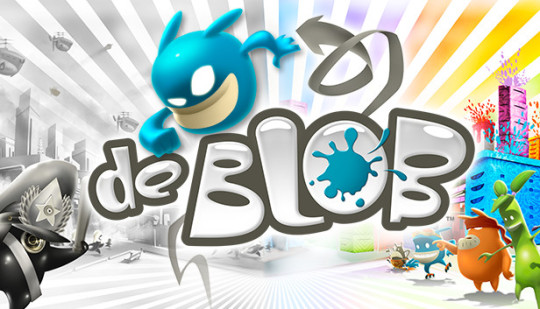
17 notes
·
View notes
Video
Weird VG11 - Chronolapse by NeitherNathan
89 notes
·
View notes
Text

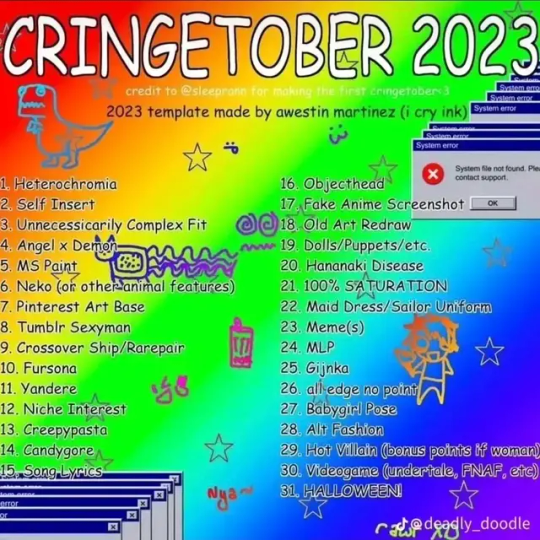
RAHHH PIG DETECTIVE PLEASSRPLEASEPLEASE MAKE A FANDOM I BEG
he is from a dreams game!! There are 4 installments in the series w a rlly interesting plot!! Its funny!! And cute!! Set in the 30s!!!
#pig detective#dreams#dreams game#media molecule#lbp#little big planet#obscure game#obscure#art#drawing#artists on tumblr#sketch#poarkchopsfunfunartgallery#digital art#commissions are open#furry
11 notes
·
View notes
Text
i should not be allowed to decompile game sound effects
5 notes
·
View notes
Text
When no more room exists in hell, the dead shall walk the earth. From the shadows shall come, heroes of all kinds, wielding weapons of different classes, each ready to knock blocks off and send zombies careening into the nearest brick wall! If you want to feel that level of excitement, check out these 20 zombie games filled with guts, gore, and glory!
#resident evil#resident evil 4 remake#re2make#re4make#horror games#zombie games#project zomboid#no more room in hell#rob zombie#mr x#xgonnagiveittoya#daymare 1998#world war z#propagation#propagation vr#ObsCure game#the walking dead tell tale#telltale#twd#days gone#the forest#dead island 2#death road to canada#nightmare of decay#dying light#organ trail#l4d#dead space remake#state of decay II#dead rising 2 off the record
9 notes
·
View notes
Text

been playing Klonoa:door to phantomile, and i think its my favourite platformer and since i enjoyed it so much, i made a drawing of the main boi, here's Klonoa himself!
------
he estado jugando Klonoa:door to phantomile, y creo que es mi plataformero favorito y ya que lo disfrute tanto, hice un dibujo del personaje principal, aqui esta Klonoa mismo!
---
the Klonoa franchise and character is owned by Namco
#klonoa#klonoa door to phantomile#klonoa fanart#cabbit#my art#playstation 1#psx#ps1 games#ps1#platformer#obscure game
4 notes
·
View notes
Text
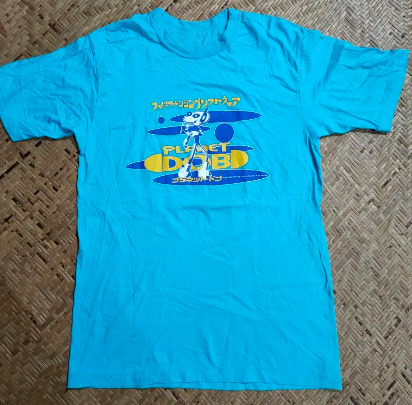


#PlanetDob #PS1 #PlayStation1 #ObscureGame #TShirt #Merch #PlantDobMerch
I'm trying to find Planet Dob Ps1 merch but I randomly found a T-shirt.
I cropped the images better.
Images not mine but link is there.
Vintage 1999 Planet DOB T-shirt, Men's Fashion, Tops & Sets, Tshirts & Polo Shirts on Carousell
What does the game over look like in Planet Dob?
3 notes
·
View notes
Photo

Meowdy, Gays & Ghouls
Here’s the schedule for 3/31-4/2
▷Watching PROXYGLITCHCAT play LITTLE NIGHTMARES
Immerse yourself in Little Nightmares, a dark whimsical tale that will confront you with your childhood fears! Help Six escape The Maw – a vast, mysterious vessel inhabited by corrupted souls looking for their next meal. As you progress on your journey, explore the most disturbing dollhouse offering a prison to escape from and a playground full of secrets to discover. Reconnect with your inner child to unleash your imagination and find the way out!
This is gonna be on Proxy’s stream - it’s her first time playing!
▷Playing SHORT SHOWCASE
🐾 😻 🐾 😻 🐾 😻 🐾 😻 🐾 😻 meow meow me౦w mEow 🐾 meow 🥮 meow meow 🐾 🐾 meow meow 🐾 🐾 meow 🐾 🐾 🐾meow 🥮 meow 🥮 🥮 mew mra mra mew meow meerow 🐟 mra mew mow 🐟 meow meow mra merow meeow meow meow meow meow (chorus: meow meow) mMMMMᎷМ 🐟 🐾 🐾 🐾 MO0ОଠOOOOOОଠଠOoooᵒᵒᵒᵒᵒᵒᵒᵒᵒw 🐾 🐾 🐾 🐾 🐟 🐾 😻 😻 😻 🐾 🐾 Meow meow
▷Playing OBSCURE with TARYNCRIMSON
For some time now, Leafmore High School has been the setting for unexplained disappearances. In this survival horror game, you take control of a group of 5 American students. With your friends, you try to unravel the mysterious happenings at this unremarkable-looking school. The night will be long and survival not will not be easy…
I’ll be playing co-op with Taryn!
▷twitch ▷discord ▷website
7 notes
·
View notes
Text
J A P A N o F I L E S # 8 -- Chronicle of Starting a Shina Soba Shop

[ The last JAPANoFILES feature was written eleven years ago. The post reached an audience of many thousands and helped create awareness about a powerful videogame creation left buried beneath the snow: Mizzurna Falls. One of its readers went on to translate the game to English, in fact. This is an impossible act to follow. In reviewing the original intention of these articles, it occurred to me that if I’m to give continuity to this effort, I should carry on seeking items of both cultural and videoludic relevance that have slipped between the cracks of history. Today’s story was one I began writing shortly before this tumbleblog hibernated and that, to my knowledge, has not yet been satisfactorily told until now by any of my fellow japanophiles. As you read it, I hope to instil in you the same gemütlichkeit you’d get from a steaming bowl of noodles on a cold winter evening.]

From the very onset, チャルメラ suggests a fascinating divide: although the title and cover art will hardly resonate with western observers, virtually anyone in Japan will instantly recognize what it is all about. To them, this is as household a name as they come, and one synonymous with precooked noodle deliciousness and convenience for over half a century.
Charumera is a much beloved line of instant noodle products introduced by Myojo Foods, a company whose foundations date back to the mid-twentieth century. Its name is interchangeable for cup noodles in many areas of Japan and the Japanese diaspora, including Brazil. The company grew a reputation for introducing some of the early revolutions in this food category that we now take for granted. In 1961, it was the first to propose the concept of cup noodles, a simplified meal preparation method made possible by ice cream type paper containers capable of withstanding the pouring of boiling water. Many misattribute this invention to Nissin due to the fact that Myojo, who lacked the wherewithal to file for a utility patent, could only profit out of their idea by selling production and commercialization rights to that prosperous food giant. The Tokyo-based company was also the first to usher in the now ubiquitous separate powder flavouring bags, initially under the name Myojo Ramen in 1962, and later rebranded as Myojo Charumera in 1966, with an improved formula that made this a reference to a fast-food seeking population.
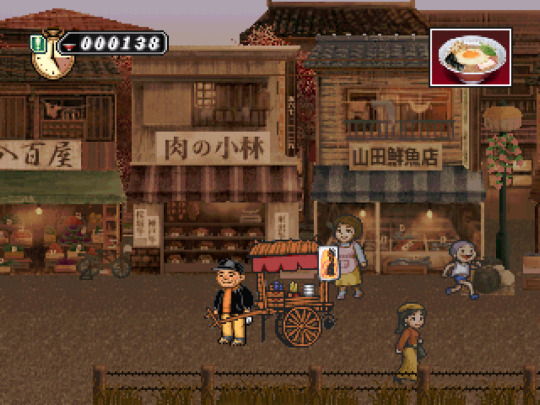
The man in the above cover art for this Playstation game adaptation, also titled Charumera, consists of the product's very own mascot, whom the Japanese lovingly call Ojisan (uncle). Few could have predicted that he would ever star in a videogame of his own. Created by Bits Laboratory and published by Victor Interactive Software on November 1999, it is unclear whether the game was sponsored or merely certified by Myojo. In the absence of more concrete information, all appears to indicate that this project was developed with the clear intent to pay homage to the brand and iconic character, only tangentially serving the purpose of advertising.
~ An ageless man carries the weight of tradition ~
In Charumera, the good uncle merrily pushes his Yatai about the streets of a fictitious town at the height of the Shōwa era. Momentarily, if the player relinquishes the control pad, he may feel at ease to wipe the sweat off his face with his chef's side towel. The streets are wide and long and barely any automobiles can be spotted. He does not speak during any of the ample verbal exchanges, although a narrator of unknown origin may on occasion report on his sentiments and reactions. He is simultaneously the central component of the game and a mere spectator to unfolding events.

A map of the aptly-named Naruto town, itself a microcosmic representation of Japan in the fifties and its dichotomy between urban and rural zones.
One part of the game has the player engage in the basic management of a mobile food stand business, starting with an understanding of the different areas of Naruto, its distant farm fields, a fishing wharf, sooty industrial zone and the bustling city centre. Each turn represents a business day, lasting from late afternoon to the wee hours of the night. Different locations at different times of the day represent varying degrees of foot traffic.
When the turn is complete, the player is free to indulge in culinary research and development, customizing all aspects of a ramen dish: the different varieties of noodles, type of bowl, seasonings, stock base and toppings. At first, the selection is limited to a set of base ingredients that can be expanded by the discovery of new areas and characters, some of them tradesmen and produce suppliers. The best selection of components ensures the most customers and, consequently, the most servings. Currency does not exist in the game. Its functional end is reached when enough meals been served for the empty bowl stack to rise above the height of the fabled mount Fuji. No small feat for a self-employed man of advancing years.
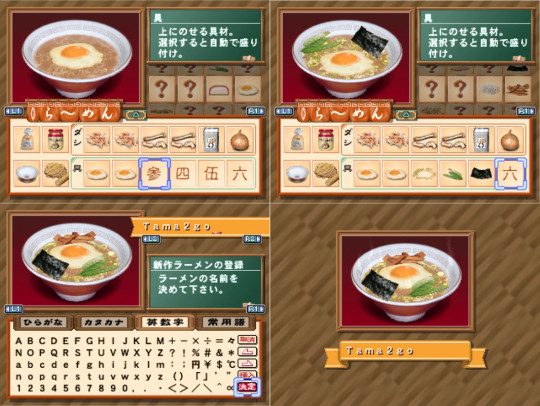
The interface for assembling Ramen bowls puts one in mind of Cybernetic’s less-than-stellar Pizza Tycoon, enabled by the overlapping of transparent bitmaps. The final presentation adds a plume of smoke to what may well turn out to be a mouth-watering success.
Charming as the business simulation aspect of the game system may be, at its heart, Charumera is an adventure centred around the exploration of a city and its denizens; one where the main goal is to bring people together through a common appreciation of the quintessential Japanese delicacy that is ramen. Scattered across the different areas, and at different times of the day, exist a number of key characters who, unlike the average passerby, will not only stop for nutritious soup but also prompt a conversation. This is done, primarily, in order for players to receive an assessment of their dishes. Some of these self-professed critics will be quite forthcoming in their comments, suggesting the flavor profile or combination of fixings most likely to please them. Others add difficulty to the game by keeping their contributions brief and enigmatic. By learning of their preferences, the player is invited to adjust the composition of the dishes and return to the same location, at the same hour of the day, to attempt another serving and achieve complete satisfaction.
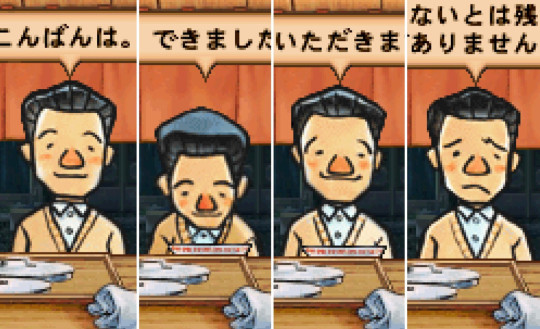
Customers tasting Ojisan’s cookery will react with different facial expressions. Some, on the other hand, will slurp his stock while remaining silent and expressionless. To captivate the more demanding customers, subtler signals need to be observed.
At times, a fully content customer's quest will be completed with a round of smiles, praise and gratitude. But on occasion, these may set in motion a more layered story to be unfolded over the remaining course of the game. An illustrative example of this is the recluse monk who is undergoing a long prayer exercise, and of whose rigorously vegeterian dietary needs can only be learned through the input from other characters who relate the motive of his abstinence. The developers also integrated a clever mechanism to aid in the understanding of what constitutes a fine plate of noodles by allowing the player to regularly visit the home of one of uncle’s best friends, a taxi driver who will be delighted to perform a tasting and attribute a score.

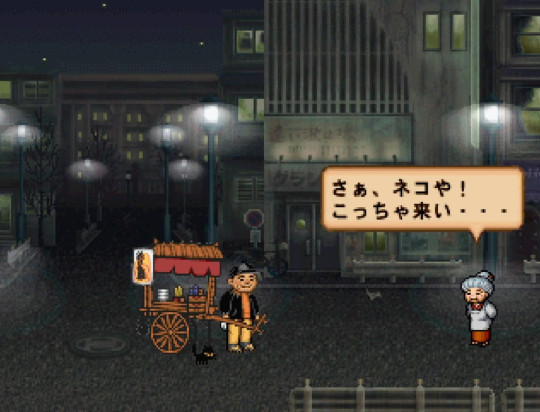
The evolution of Ojisan’s design over the years observed some changes including a much needed footgear upgrade from hardwood zori to a snug pair of sneakers (left). The alternative, far less inspired cover art for the game's second edition (right). The black cat Suzuneko only makes its first appearance a couple of hours into the game as a part of a substory (bottom).
~ Sweet shawm music ~
The long tradition of Yatai-wheeling cooks is only supplanted in age by ramen itself. Decades before it came to known by its present name, noodle soup was commonly referred to in Japan as Shina Soba, a clear enough reference to its nonetheless opaque Chinese ancestry. Japan’s fast-paced industrial development in the late 19th century caused severe economic and demographic changes. A host of policies adopted by the government expedited the rift between an increasingly impoverished and isolated countryside population, for whom labour-intensive agriculture was no longer a profitable activity in view of neighbouring competition. This resulted in an exodus to the cities, in droves, and the search for the opportunity of low-level employment in manufacturing. The extended work hours and taxing duties of factories paved the way for a new type of meal, one substantial enough to sustain workers and at the same time affordable for regular consumption.
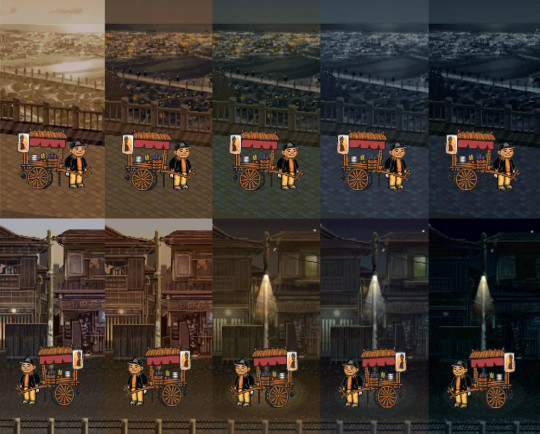
The passing of time is strikingly reflected in the backgrounds, the result of a clever combination of gradual colour scheme alterations and the loading of new bitmaps. The switch of music themes equally signals the change.
Wheat flour imports from Korea and Taiwan being more affordable than Japanese rice, this new noodle soup found its way among the most predominant food offerings of the early 20th century; first introduced by Chinese emigrant-owned eateries and later integrated into even the most traditional Japanese restaurants in view of its high demand. Yatai, already used for many decades in Japan to bring prepared food to residences, were one of the prime vehicles behind the propagation of Shina Soba by keeping this delicacy in permanently close reach.

As illustrated by the emblematic Charumera product logo, the sounding of the horn is an instrumental ritual of food cart owners, enabling their presence to be known. Conversely, this is a recurring action performed in the game with the pressing of the O button. Once the sound plays, bystanders will gather around the ever-cheerful uncle.
The name ‘charumera’ refers to a double-reed woodwind instrument that is said to have derived from ‘charamela’ – Portuguese for shawm -, hinting at a possible introduction to the Japanese by way of Christian missionaries from that provenance sometime during the 16th century. The simplicity of the instrument made it popular among pushcart owners, not only because its sound signalled their impending arrival, but also due to the clever employment of signature melodies in what can only be described as a primordial manifestation of brand awareness. All these practices are exquisitely demonstrated in a scene from Yasujirō Ozu’s 1936 film Hitori Musuko (The Only Son). Needless to say, a viewing of the entire picture is most advised.
~ Ramen as the expression of longing for a bygone era ~
In the present, where connections to history have been severed, ramen is a tool to rearticulate the charm of Japan’s traditions. - Hayamizu Kenrō
There couldn’t have been a more appropriate moment to reintroduce Charumera. Ramen is more of a nipponic cuisine staple than it has ever been before, sustaining its high demand across the islands, each region unyieldingly asserting the superiority of their own rendition. As for the rest of the world, ramen has long expanded beyond the constricted cubbyholes in which it remained for decades, when only urbane gourmets or ablutophobic otakus dared to publicly utter the word above a whisper.
Japan is presently witnessing an intriguing wave of nostalgia for the Showa era, as evidenced by the multitude of visitors to the recently inaugurated Yūhi No Oka Shōtengai (Sunset Hill Shopping Street) at Seibuen Yenchi, a massive theme part located in the Saitama prefecture of Tokyo. The concept behind this attraction is to recreate the life of a small shopping district from the 1960s, faithfully capturing the architecture, décor, fashion, transportation, advertising, stores and products from this period. Visitors seem delighted at the prospect of evasion to what they perceive as an easier, more compassionate style of living. (recommended viewing: NHK feature "Showa Nostalgia", May 2022).

A similar ideal is humbly pursued with this unique software: the use of modern technologies as a medium to connect to younger game-playing audiences, reciting a tale from a time when simple pleasures such as a cup of hot soup were deemed an enriching experience, for those preparing and feasting on it alike. Its only message is the celebration of amity and unity, as conveyed by its ultimate purpose: to weave lasting bonds with the community, establish the business as a local institution by acts of kindness and cooperation, inspire followers through hard work ethics and gain full support of every element of society. Its period recreation prowess may lack the verve of SEGA’s seminal Shenmue, published that same year. The exploits of its game system surely pale in comparison with the gargantuan catalogue of expansive role-playing games for which this epoch came to be celebrated. This is, after all, the product of nearly self-sufficient designers making as good a use of their previously acquired skills and experience as was permitted by the modesty of the budget in reach. In true indie form, it nevertheless excels at what the majority of the towering productions of the day failed to possess – a soul.
~ Heisei 11: the year of digital noodles ~
Though infrequent at the turn of the century, food and cooking themed video games have witnessed a vast expansion in popularity, presently existing in numbers sufficient to constitute a subgenre all their own. The ordinariness of most proposals in this category of late, however, beg for a tribute to earlier accomplishments. In general, food has been a pervasive theme in Japanese games since the early 1980s – after all, what is Pac-Man’s main premise if not to devour? For the purposes of this article, a more refined search is required to single out those pertinent creations still shrouded in relative obscurity.
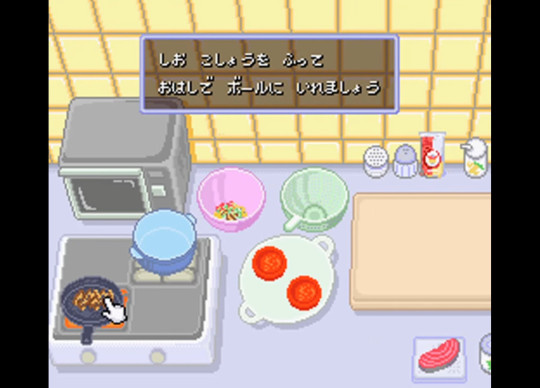
Ajinomoto's foray into the world of video game product placement may have been the unintentional inspiration for a brave new console game category.
Certainly, one of the first Japanese games on the subject of cooking was Motoko-chan no Wonder Kitchen, a 1993 promotional Super Famicom cartridge obtainable only in return for mailing Ajinomoto mayonnaise cut-out label seals, all part of a contest for which ten thousand units were produced. The relevance of this game cannot be overstated: not only does it produce an early example of a stunningly functional dish assembly minigame, it also represents the early days of that obscure Japanese tradition wherein the video game space is permeated by advertising from large-scale food corporations.
A year later, the doyen of bishōjo games, KID, teamed up with Nissin Foods to give digital life to UFO Kamen Yakisoban, the superhero from their saucer-shaped yakisoba cup noodle ad, this time for an eccentric Super Famicom beat ‘em up in which the kitchen remains off-limits. In early 1999, KID would in turn partner with PepsiCo for the production of Pepsiman on the Playstation, Japan’s most recognizable face for the world-renowned soft drink, a game that garnered cult following among western players in the early 2000s.
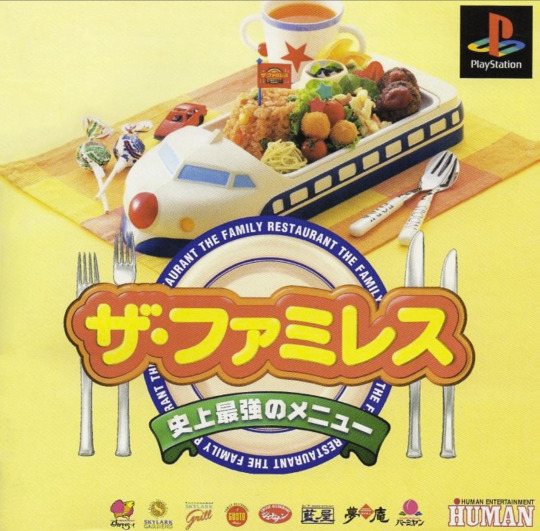
It never ceases to amaze how many ports of The Family Restaurant hit the market between 1998 and 2000 alone. Just a year after the original Masterpiece game, a slightly improved version developed by ArtDink also made its way to the PC. There were also three editions of the game for the Playstation, each a unique variation of the base design. Notably, the Human edition included a partnership deal with the Skylark group, advertising a handful of their most beloved restaurant chains. The above cover art boasts the logos for Yumean, Aiya, Jonathan, Gusto and the temple of Chinese food deliciousness, Bamiyan.
Other honourable mentions from the latter half of the decade include Burger Burger, a Maxis/Bullfrog styled fast-food chain restaurant strategy simulator designed by board game designer and 1988 Monopoly word-champion Hyakuta Ikuo; the 1998 Masterpiece personal computer game Za Famiresu (The Family Restaurant), another restaurant business sim ported to the Playstation in 1999 by Human Entertainment, in an edition rececing the sponsorship from the major restaurant group Skylark; and Cooking Fighter Hao, a remarkably unusual Nippon-Ichi combat game in which the player slashes live animals for meals to be prepared.

Ore No Ryouru demands impeccable chopping skills at the cost of a few fingers (left). A leering look at historical Japanese society, Ramen Bashi is best described as a game of customs (right).
The year of 1999 represented a peak of creativity within the genre. Invariably, the first piece of evidence sustaining this claim is Ore No Ryouri, the result of a partnership between Sony and Argent intended to support marketing efforts for the original Dual Shock controller. Much like Saru Getchu, the game makes sensible use of the dual sticks in replicating the taxing kinesis that restaurant-grade food preparation entails. The game was a small success in Japan due to its hilarity and frantic pace, meriting a Playstation the Best edition and PS3/Vita rerelease.
Making its appearance mere weeks before Charumera, Ramen Bashi, developed by Media Entertainment, is another triumph from that same year, one that remains largely unappreciated even among Japanese players. Unlike the aforementioned oddities, novelties and brazen publicity stunts, this is a game of some depth and complexity. In it, the player assumes the role of a soldier demobilized from Siberia after the war who takes over his father’s ramen shop, finding himself encircled by a society of commoners, thugs and other such unpleasant people that, throughout the four decades during which the game takes place, ceaselessly prey on his Hakaiou-like, short-tempered nature. For every ounce of heart that Charumera possesses, Ramen Bashi matches it with its peculiar brand of satire and sardonic humour. So caustic, in fact, that the studio was forced to tone it down in for their ensuing gourmet series, referred to by some as the holy trinity of PlayStation cooking games - Yakiniku Bugyo, Nabe Kazoku, and Yakitori Musume. An article of similar scope to this one has yet to be written about any of them.
More JAPANoFILES features
JAPANoFILES #7 - Country of Bears and Burgers
JAPANoFILES #6 - Violent Cop
#playstation#sony#ramen#myojo#nissin#charumera#instant ramen#videogame#obscure games#obscure game#Japanese food
31 notes
·
View notes
Text
Anyone else have a gay crush on this bitch?
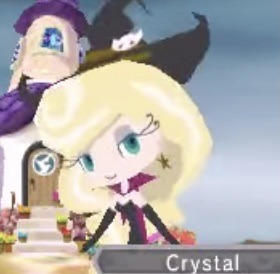
#obscure games#3ds games#gabriellas ghostly groove#gay crush#fictional crushes#3ds#nintendo 3ds#obscure game#obscure characters
4 notes
·
View notes
Text
Astro Pinball (VTech Creativision, 1981)
You can play it in your browser here. You can read the manual here.
Controls: F10, Control or Shift to select mode, Z or any of several other keys to start playing and to use the plunger, Shift for left flipper, Ctrl for right plunger..


#internet archive#game#games#video game#video games#videogame#videogames#obscure game#obscure games#vtech#obscure console#obscure consoles#pinball#box art#game box art#game cover#1981#1982#1980s#1980's#80s#80's#.
56 notes
·
View notes
Text
Josh Carter x Shannon Matthews

#obscure#obscure game#games#game aesthetic#game#Shannon Matthews#Josh Carter#aesthetic#Spotify#Перемотка#my otp#otp#pairing#au#alternative au#character aesthetic#moodboards#moodboard
5 notes
·
View notes
Video
Weird VG9 - OutlawN by Programancer
9 notes
·
View notes
Video
youtube
Sanatory Hallways: Whose Hunting Who? - GB Mini
Happy Bonfire Night/Guy Fawkes Day!
I’ll be honest, I didn’t have a video planned for this distinctly British holiday nor did I have a video planned for Halloween, but I feel this obscure Wii U horror game can serve well enough as a celebration for both. By the way, I highly recommend buying Wii U eShop games whilst you can, including this one if it interests you.
Perhaps in future I should prepare a special video for this British holiday... and one for Pancake Day as well of course. What games would be befitting for these days though? I’ll have to think on that.
GB Mini Art by Cipple: https://cipple.deviantart.com/art/Mini-Gb-Banner-commission-719388713
Nanka Art by Mgcoco: https://mgcoco.tumblr.com/post/169716254081/a-commission-for-the-grinbrothers-youtube
Hat Art by Sakka-sama: https://www.deviantart.com/sakka-sama/art/Com-Hat-833535464
Souldin Short Start Art by KymmaFox: https://rinniekuu.deviantart.com/art/COMM-Nanka-736009883
Kick-Off Nanka by Louverusee: https://www.deviantart.com/louverusee/art/CM-Kick-Off-749467325
Grin Brothers Endslate by LittlePancake94: https://www.deviantart.com/littlepancake94/art/Commission-Nanka-And-Hat-847329974
Sanatory Hallways is exclusive to Wii U.
Date Made: 11/8/2022
YouTube: https://www.youtube.com/@grinbrothers
Tumblr: http://grinbrothers.tumblr.com/
Twitter: https://twitter.com/GrinBrothers
#youtube#sanatory hallways#wii u#indie game#nindie#eshop#wii u digital game#wiiu#grin brothers#bonfire night#guy fawkes day#fireworks night#horror game#obscure game#wii u gamepad#charla#mr spook#wegenbartho#asymetrical multiplayer#nintendo wii u#wii u eshop#grinbrothers
3 notes
·
View notes
Text
Neko Zamurai (Japan) PSX All FMVs
youtube
0 notes